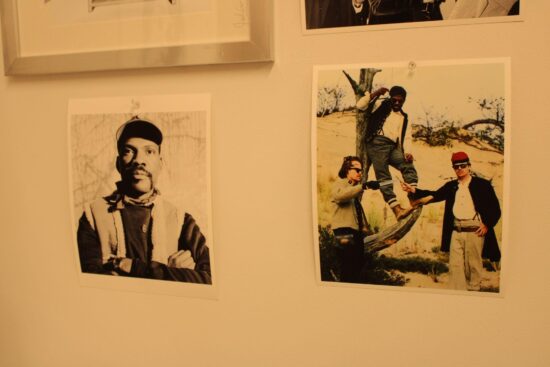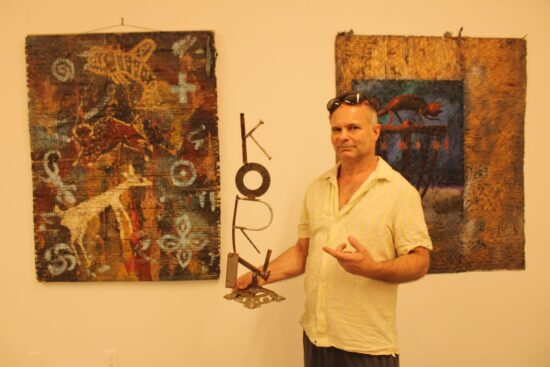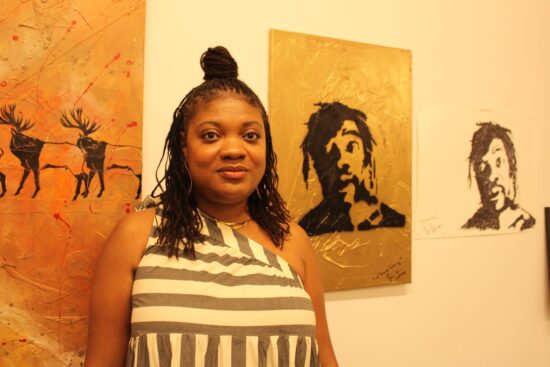For a decade after his death, Thom Corn’s artwork went largely unnoticed. A new exhibit at Wallworks New York shines light on the little known artist who touched many in his lifetime.
In November 2023, Nancy August got a call from her friend Ron Maseroni. He wanted her to ask around about Thom Corn, an artist and former tenant in a building he owned on Avenue D on the Lower East Side. Corn passed away in 2014, and since then, Maseroni had kept his artworks displayed in the lobby of the building and at his own home in Southampton, unsure of their value.
August, a filmmaker and curator, quickly began asking friends and colleagues about Corn. She’d never heard of him, but it seemed everyone else had. Corn was well known in the Lower East Side art scene in the 1980s and 90s, but his work never achieved widespread attention in his lifetime.

“Everybody had a story,” said August about Corn, who was also a musician, and known for his infamous New Years Day parties. “He was a very tough individual in a lot of ways, but he did have a heart of gold.”
After learning about Thom and seeing his work, August reached out to John “Crash” Matos of Wallworks gallery about putting on an exhibition. August chose Wallworks because the gallery was founded in the spirit of Fashion Moda, an iconic art space in Mott Haven where Thom showed his work in several group shows.
“It [Fashion Moda] included artwork from the neighborhood, but also it invited artwork from downtown, so Lower East Side artists were coming up to the Bronx and working with Bronx artists,” said Anna Matos, Gallery Director of Wallworks. “It was a really synergetic art space, and we wanted to have a similar vibe when we opened Wallworks.”
The exhibit “The Found Art of Thom Corn” opened at Wallworks on September 14th and runs through October 18th. It features 22 pieces of Corn’s art, in addition to works inspired by Thom and created by fellow artists who knew him. Eight of the works are for sale.
A self portrait of Thom holding a banjo, an instrument of African origin synonymous with American folk music, greets visitors to the exhibit. Much of the exhibit’s colorful works are made from found materials assembled on chicken wire. Others are paintings on canvas or wood. The majority were left untitled, but one, “The Fear of Man”, features a procession of deer looking backward. Several of the works include Adinkra symbols representing various concepts in Ghanaian philosophy.
Andy Shand, a friend of Corn’s who first met him in the 1980s, believes his work dealt with themes of identity. “His roots were important to him. He was living in a modern world, doing modern stuff, but looking backwards in time,” said Shand. “Thom was very sensitive to the world around him. He wasn’t a sort of artist that would go into the studio and cut himself off. The world was his kind of his inspiration.”
Linus Corragio, an artist and friend of Thom who created a sculpture inspired by Corn for the exhibit described him as an “iconoclast.” “Each piece was pretty different from the last, and he just went with his ideas of the moment. He wasn’t developing a series or a signature style, and I think that attests to his open-minded creativity,” said Corragio.

In the ’80s, artist Jim C. played in a band called “Avant Garage” with Corn. “He played drums. I played the wave station synthesizer,” said C. “Thom was like a ball of energy. I mean, like a crazy, Hellfire ball of energy, so much alive. And it’s hard to conceive of him not being here.”
For Corn’s daughter Rayna Lucier, seeing her father’s works on display is “complex”. She did not meet Corn until she was 22, just a few years before his death. “I knew he was an artist, and I was an artist too, I was like, I need to meet the other part of my DNA,” said Lucier, an illustrator. “I only had a few years with him, but in that time, I feel like I got a grasp of who he was.”

Lucier says she was “in and out” of Corn’s life in his final years but did see him a couple months before he died when he was in poor health.
“I would credit him with being able to see that example that you can make this your make a living this way, if you really want to, if you’re passionate,” said Lucier. “Sometimes when we leave the earth, we’re not in the best condition, and he was definitely not exempt from that, but he left a rich legacy of artwork.”
Wallworks NY is located at Bronx Kreate Hub 15 Canal Place Bronx, NY 10451. The gallery is open Wednesday through Friday from 11 a.m. to 4 p.m.

